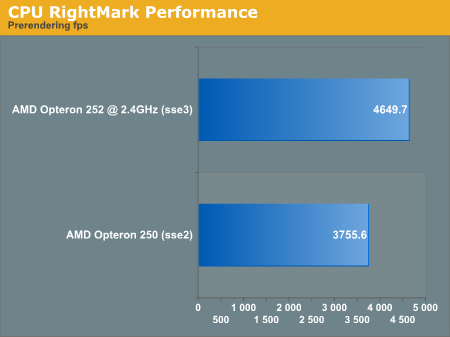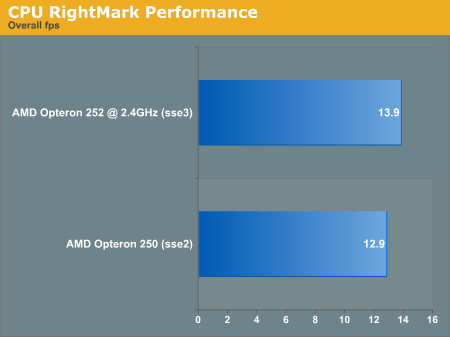AMD K8 E4 Stepping: SSE3 Performance
by Derek Wilson on February 17, 2005 12:05 AM EST- Posted in
- CPUs
SSE3 Performance Analysis
Before running these tests, we confirmed that SSE3 was enabled with the Opteron 252 through CPU-Z.The first test that we will look at is DivX encoding. We used DivX 5.2.1 with AutoGK 1.91 as a front end. Chapters 19, 20 and 21 of The Chronicles of Riddick were used as the test material for this analysis. We turned off audio and used the 75% quality setting.

The second test that we looked at was purely synthetic. CPU RightMark uses the processor to manage the physics and rendering of a 3D scene. There are lots of configuration options, but we went with the default for each CPU that we tested (just start up the program and hit run). The highest level of floating point support is chosen automatically in each case (SSE2 for Opteron 250, and SSE3 for Opteron 252 @ 2.4GHz).













48 Comments
View All Comments
Beenthere - Thursday, February 17, 2005 - link
The only reason Intel created SSE3 was to have bogus benchmarks to fool naive consumers. There is no significant performance advanatage in any application. When you're Intel and you can provide incentives for benchmarks to be written to your liking to show a fantasy performance advantage, and your product line is obsolete and your market share is dropping, you do whatever you can to deceive consumers and hacks. AMD included SSE3 so Intel couldn't use the bogus benchmarks for misleading marketing purposes.This is no different than when MICROSUCKS paid to have benchmarks run that showed Win2000 to be faster than NT4 when in fact it is NOT in actual practice.
SOD, DD
Time for PC users to become a little more knowledgeable on the scams being used by dishonest companies to hawk inferior products.
Carfax - Thursday, February 17, 2005 - link
Hey Derek. Could you test SSE2 performance aswell?As it has been mentioned, the E stepping was rumored to possess a better SSE2 implementation.
iwodo - Thursday, February 17, 2005 - link
I always thought E core stepping is going to bring many things new on the table.Improved memory contoller, that is suppose to be faster and have better compbality.
Improved SSE2 core - More performance.
Better Cache Latency
SIO - Lower TDP...........
Where is all these in the review? Or are they just total rumors or They are not avalible on Opertron?
DerekWilson - Thursday, February 17, 2005 - link
Oh, but back on topic... I've had a lot of emails about AMD simply mapping SSE3 functionality to SSE2 (or even x87) hardware. This would be a very bad idea for AMD and doesn't look like what they are doing.If we had seen AMD impliment the entire SSE3 instruction set as essentially macros for SSE2 we would likely have seen a performance drop. There's not an easy way to just map some of the instructions, as optimal performance would require a recompile. We actually saw a performance gain in our synthetic benchmark that used some of the floating point instructions.
It is possible some instructions could be treated this way. For example, there's no reason the code that uses a standard method to load 16 bytes (that may or may not be unaligned) and lddqu should look different.
DerekWilson - Thursday, February 17, 2005 - link
No one uese Opteron?http://www.anandtech.com/IT/showdoc.aspx?i=2173
Also, if you need 4P or more, there's no reason to limit yourself by going with Intel's FSB implimentation -- It really hurts the performance of the system:
http://www.anandtech.com/IT/showdoc.aspx?i=1982
xsilver - Thursday, February 17, 2005 - link
old habit ?Its called perception lag -- when perception (of intel being good) needs to catch up to reality .... oh and also blame it on companies like dell etc.
Brunnis - Thursday, February 17, 2005 - link
bigpow: But then again, I wouldn't go with Opteron too.Why not? Opteron is better than Xeon in many areas.
A large reason why many companies don't use much else than Intel products are probably because of old habit. That's just stupid, in my opinion, but everyone's different...
sandorski - Thursday, February 17, 2005 - link
Bigpow: Opteron has gone from 0-10% marketshare in he server space. So it's not surprising that you nor anyone you know has them, but they are being used and last I heard they were still gaining Marketshare.Samadhi - Thursday, February 17, 2005 - link
It has been written in a number of places that as well as adding SSE3 units the SSE2 units were to be improved in the latest chip revision.Any chance we could get some SSE2 vs SSE2 results for the two processors tested in this article?
SkAiN - Thursday, February 17, 2005 - link
Sorry for the blank post.When I first began reading this article, I became excited, looking forward to seeing the benchmarks this "upgrade" was supposed to bring, especially in the area of encoding.
Then I saw the benchmarks.
Seriously, it looks as if AMD is getting the short end of the stick when it comes to the cross-licensing deal with Intel. Intel gets awesome new architechture, A64's get Intel's bogus hype...